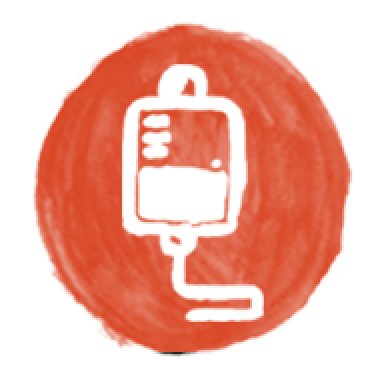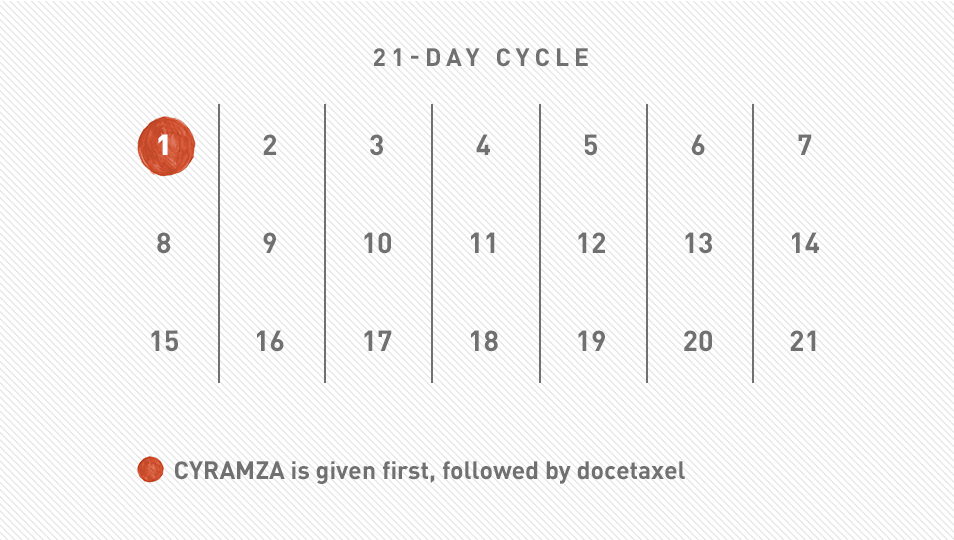
When living with metastatic non-small cell lung cancer (mNSCLC)...
CYRAMZA can help keep you fighting for what matters to you
You’re not the type to settle for average. You’re the type who pushes for more. But where individual results with CYRAMZA can vary, clinical studies have shown...

More time without disease progression
36% of people had delayed disease progression for 6 months or longer with CYRAMZA + docetaxeI (a type of chemotherapy) vs 29% with chemotherapy alone
- Half of the people who received CYRAMZA + chemotherapy lived without their cancer getting worse for 4.5 months vs 3.0 months with chemotherapy alone

More people had tumor shrinkage
More people had their tumors shrink with CYRAMZA + chemotherapy vs chemotherapy alone
- Tumors shrank (by 30% or more) in 23% of people taking CYRAMZA + chemotherapy vs 14% taking chemotherapy alone

Cyramza may help you live longer
43% of people lived 1 year or longer with CYRAMZA + chemotherapy vs 38% with chemotherapy alone
- Half of the people who received CYRAMZA + chemotherapy after their cancer progressed were still alive at 10.5 months vs 9.1 months with chemotherapy alone
CYRAMZA was studied in a clinical trial of 1253 people with locally advanced or metastatic non-small cell lung cancer who received CYRAMZA + docetaxel (628 people) vs those who received docetaxel alone (625 people). All people in the study had previously received platinum-containing chemotherapy.
SELECT SAFETY INFORMATION
CYRAMZA may cause serious side effects, including:
Severe bleeding, including bleeding in the stomach or bowel, has happened with CYRAMZA. This can be life threatening. Tell your doctor right away if you have bleeding or symptoms of bleeding, including lightheadedness. If severe bleeding happens, you will have to stop receiving CYRAMZA.
Explore the Lilly Oncology Support Center for information on savings and financial assistance.
What to expect during treatment
You’ve decided to move forward and are ready to start treatment. Let’s do this.

Treatment will be given by an intravenous (IV) infusion, in either the doctor's office, a hospital, or an infusion center.

First, you'll be given CYRAMZA (60- minute infusion), followed by docetaxel (60 minute infusion). If you handle the first infusion of CYRAMZA well, then your next CYRAMZA infusions may only take 30 minutes.
Before you receive CYRAMZA, your doctor will give you different medicines to help prevent an allergic reaction that may occur during the infusion.

CYRAMZA will be given in combination with docetaxel (a type of chemotherapy).
Understanding your dosing schedule with CYRAMZA

CYRAMZA + DOCETAXEL (A TYPE OF CHEMOTHERAPY)
CYRAMZA + docetaxel will be given to you once every 3 weeks, or as recommended by your doctor.
Your doctor will determine the number of treatments you receive.
SELECT SAFETY INFORMATION
CYRAMZA may cause serious side effects, including:
Reactions related to infusing CYRAMZA have happened. These can be severe and life threatening. Most of these reactions happened during or after the first or second CYRAMZA infusion. Symptoms of infusion reactions include shaking or stiffness of the body, back pain or spasms, chest pain or tightness, chills, flushing (sudden warmth and/or reddened skin on the face, neck, or upper chest), difficulty breathing, wheezing (a whistling sound in the breath caused by narrowed breathing tubes), becoming blue due to lack of oxygen, and tingling or numbness of the skin. In severe reactions, rapid heartbeat, low blood pressure, and severe trouble breathing may happen. Your health care team will give you medicine before each CYRAMZA infusion and will watch you for these side effects. If a reaction happens, CYRAMZA treatment may be infused at a slower rate or may be permanently stopped, depending on how severe the reaction is.
Tips for day of treatment and beyond
You may be nervous about your first treatment. Or maybe you're an old pro at this. But no matter where you're coming from, here are some important tips to help get you through each infusion with CYRAMZA:
Understanding common side effects
CYRAMZA in combination with docetaxel (a type of chemotherapy) may cause side effects. If you experience new symptoms while on treatment, it is important that you speak with your doctor.
Explore the most common side effects of CYRAMZA, below.

The most common side effects were:
Low white blood cell count, tiredness, mouth sores and swelling in the lining of the mouth, nosebleeds, low white blood cell count with fever, swelling in the arms, legs, hands, or feet, low platelet count, increased production of tears, and high blood pressure.
The most common serious side effects were:
Low white blood cell count with fever, pneumonia, and low white blood cell count – Medication to increase white blood cell count was given to 42% of CYRAMZA plus docetaxel-treated patients and 37% of patients who received placebo plus docetaxel.
Talk to your doctor about any questions, concerns, or side effects you might have with CYRAMZA. Your doctor may be able to make recommendations to help you feel more comfortable.
You are encouraged to report negative side effects of prescription drugs to the FDA. Visit www.fda.gov/safety/medwatch or call 1-800-FDA-1088.
Please see Safety Summary for more safety information for CYRAMZA.
